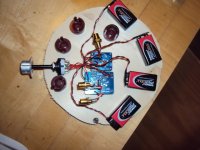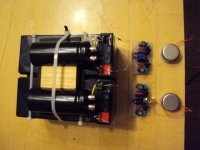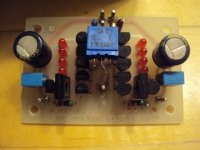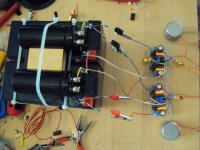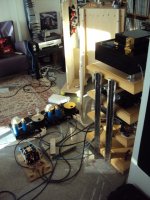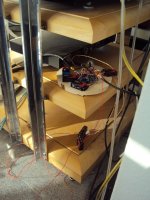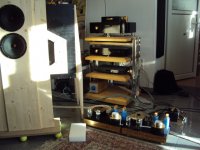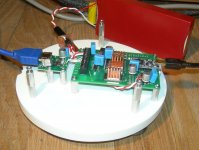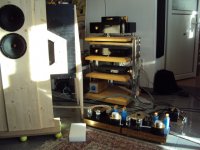Joachim,
You see how you get me into trouble.
There are guys sending me PMs to be asked to be put on a waiting list, before I even tested anything.
This is your magic and not mine, for sure.
Patrick
PS
If you guys really want to queue, and I do not encourage that by ANY means, please do it at the GB forum and not here, and not by sending me PM's.
Please keep this for technical discussions, for the benefit of all.
You see how you get me into trouble.
There are guys sending me PMs to be asked to be put on a waiting list, before I even tested anything.
This is your magic and not mine, for sure.
Patrick
PS
If you guys really want to queue, and I do not encourage that by ANY means, please do it at the GB forum and not here, and not by sending me PM's.
Please keep this for technical discussions, for the benefit of all.
Last edited:
I am sorry about that inconvenience. I just ry to help to get the best possible sound out of your creation. I have the same going on on my MPP thread. I never dreamed even that i got so much attention.
So guys, please be patient. I am about to build a test board so that i can access the basic sound quality. Then i know more.
So guys, please be patient. I am about to build a test board so that i can access the basic sound quality. Then i know more.
Joachim,
I want to say openly that I am most grateful for your input, not only here but also in the SEN IV thread.
These open technical discussions bring the circuit forward.
And since it is open discussion, it is for the benefit for all.
But I fully respect it is your circuit, and I shall only make it available as modules if you want me to.
You have full control.
And no inconvenience at all. Just a lot of fun.

Patrick
I want to say openly that I am most grateful for your input, not only here but also in the SEN IV thread.
These open technical discussions bring the circuit forward.
And since it is open discussion, it is for the benefit for all.
But I fully respect it is your circuit, and I shall only make it available as modules if you want me to.
You have full control.
And no inconvenience at all. Just a lot of fun.
Patrick
Ok, first i have to listen to it and then measure. If i am satisfied you can go ahead and design a module. That should not discourage anybody to make his own experiments.
I can only say your board as it is sounds just fine. My wife and my secretary think it it cute so there is some acceptance.
I can only say your board as it is sounds just fine. My wife and my secretary think it it cute so there is some acceptance.
After initial success i had some trouble to make the Wolfson input receiver look. After consulting with EUVL i made a switch that connects all 4 batteries at the same time. BINGO, it works. This time with the Forsell as transport and much shorter wiring to my power amps. The sound : I was speechless. Much more energy then before. Mind you, this does not sound like analog at all. It is a very honest sound that brings out the best and the worse in the recording. From silky smooth tube recordings like Harry Belafonte at Carnegy Hall to rough and ready Mary J. Blidge. There still is this this tiny bit of artifice. I have to listen more but i am already addicted.
Attachments
Joachim,
If I get some time around Easter, there is a balanced version to try.
And if you would invest in a QA550 as a temporary solution (our own is not ready in 6months), you can also drive the player and the DAC (without the Wolfson) with one single clock at 45.584MHz.
There is a lot more to come with this harmless looking chip.
But next thing we all look forward to your filter buffer.
Patrick
If I get some time around Easter, there is a balanced version to try.
And if you would invest in a QA550 as a temporary solution (our own is not ready in 6months), you can also drive the player and the DAC (without the Wolfson) with one single clock at 45.584MHz.
There is a lot more to come with this harmless looking chip.
But next thing we all look forward to your filter buffer.
Patrick
OK, this is an SD card reader. I may get one from my friends in Japan. They are working on a High End reader.
I the meantime i have dimensioned the filter ( now called filter 3 ) for my 24mH Sowter coils. The 4,7nF can now be kept, the resistor has to be increased to 14kOhm. This is similar to filter 2, accurate to 0.02dB. Actually to change the resistor makes tuning possible so using a 10kOhm makes the filter a bit steeper or 20kOhm makes it softer.
I will actually not use the Fet cascode buffer but my Hawksford Buffer. I have adopted the driven cascode idea for a buffer. Usually it is used in the VAS so i think this is novel.
I the meantime i have dimensioned the filter ( now called filter 3 ) for my 24mH Sowter coils. The 4,7nF can now be kept, the resistor has to be increased to 14kOhm. This is similar to filter 2, accurate to 0.02dB. Actually to change the resistor makes tuning possible so using a 10kOhm makes the filter a bit steeper or 20kOhm makes it softer.
I will actually not use the Fet cascode buffer but my Hawksford Buffer. I have adopted the driven cascode idea for a buffer. Usually it is used in the VAS so i think this is novel.
Attachments
Here is a picture of the experimental setup and a closeup of the buffer.
I know it´s big and using 20 expensive and rare Fets is crazy.
The buffer sounds pretty decent though. One of my better efforts.
I know it´s big and using 20 expensive and rare Fets is crazy.
The buffer sounds pretty decent though. One of my better efforts.
Attachments
Thanks Joachim for your valuable input and EUVL for bringing up the attention to this wonderful sounding DAC. I love mine.
REPOST from other thread:
------------------------------
I want to draw the attention to one thing I' ve discovered that brings the sound to a new level, stereo image gets wider, natural sound, very good sound.
I wanted to get rid of the internal charge pump inverter, so I omitted the Cfly capacitor (the capacitor between CP and Cn), thus disabling de facto the switched transfer of current from Vin to NEG.
Since negative voltage is not coming from the pump, I tried connecting a quiet good source (lifepo) to NEG pin.. actually a lifepo with the minus to NEG and positive to GND.
DC offset similar to the original circuit.. 2/3 mV.
DC servo seems to track well the -3.2/3.3 from the lifepo.. the pump circuit output was a bit less (-3.1V if I remember correctly).
in my setup very good result with this simple mod.
anyone willing to try and confirm this?
PS: pay attention to DC offset.. if you leave connected alone Vneg you'll find DC at the output. you need both Vin, NEG, and omit only Cfly across Cp/Cn.
Valeriano
REPOST from other thread:
------------------------------
I want to draw the attention to one thing I' ve discovered that brings the sound to a new level, stereo image gets wider, natural sound, very good sound.
I wanted to get rid of the internal charge pump inverter, so I omitted the Cfly capacitor (the capacitor between CP and Cn), thus disabling de facto the switched transfer of current from Vin to NEG.
Since negative voltage is not coming from the pump, I tried connecting a quiet good source (lifepo) to NEG pin.. actually a lifepo with the minus to NEG and positive to GND.
DC offset similar to the original circuit.. 2/3 mV.
DC servo seems to track well the -3.2/3.3 from the lifepo.. the pump circuit output was a bit less (-3.1V if I remember correctly).
in my setup very good result with this simple mod.
anyone willing to try and confirm this?
PS: pay attention to DC offset.. if you leave connected alone Vneg you'll find DC at the output. you need both Vin, NEG, and omit only Cfly across Cp/Cn.
Valeriano
I can not believe it. The filter works right away without problems.
The sound : smooth, much more "tone", more body, bigger stage with still excellent focus.
So far no objections.
I had to reduce the volume of my sub a little bit but then it snapped into focus.
i know, i am biased but i have tried this inductor trick many time with always the same outcome. High Frequency noise has to be kept down in digital. I am convinced about that.
The sound : smooth, much more "tone", more body, bigger stage with still excellent focus.
So far no objections.
I had to reduce the volume of my sub a little bit but then it snapped into focus.
i know, i am biased but i have tried this inductor trick many time with always the same outcome. High Frequency noise has to be kept down in digital. I am convinced about that.
Attachments
Joachim,
If you are preapred to use 10 JFETs in parallel / Push-Pull, then you should give my DAO follower a try.
It runs the cascoded LU1014 in triode mode, and will drive 30 ohm load happily.
Now, the challenge is to make the same sound with €1.50 an inductor and €0.50 a piece JFETs.
And all in a PCB of comparable size to the 9022 module.

Patrick
If you are preapred to use 10 JFETs in parallel / Push-Pull, then you should give my DAO follower a try.
It runs the cascoded LU1014 in triode mode, and will drive 30 ohm load happily.
Now, the challenge is to make the same sound with €1.50 an inductor and €0.50 a piece JFETs.
And all in a PCB of comparable size to the 9022 module.
Patrick
I can not believe it. The filter works right away without problems.
The sound : smooth, much more "tone", more body, bigger stage with still excellent focus.
So far no objections.
I had to reduce the volume of my sub a little bit but then it snapped into focus.
i know, i am biased but i have tried this inductor trick many time with always the same outcome. High Frequency noise has to be kept down in digital. I am convinced about that.
Hi Joachim,
Do you see any physical resemblance between my attached picture to the device you have in your rack
PS! If you feed the ES9022/3 DAC with true 24bit data the last of the "There still is this this tiny bit of artifice" will be removed and you can either drop your filter or change it to a greater pass band.
The SD card player you mentioned from our friends in Japan, the Titan USB -> I2S board or the exaU2I USB -> I2S board (in the attached picture) are the sources I know that will give the best results with ES DACs..
Attachments
Joachim,
If you are preapred to use 10 JFETs in parallel / Push-Pull, then you should give my DAO follower a try.
It runs the cascoded LU1014 in triode mode, and will drive 30 ohm load happily.
Now, the challenge is to make the same sound with €1.50 an inductor and €0.50 a piece JFETs.
And all in a PCB of comparable size to the 9022 module.
Patrick
Slightly OT, but i have been mullling the idea of trying a power amp version of your DAO with R085's from Semisouth. What do you think?
- Status
- This old topic is closed. If you want to reopen this topic, contact a moderator using the "Report Post" button.
- Home
- Source & Line
- Digital Line Level
- Anybody using the new ESS Vout DAC (ES9022)?
